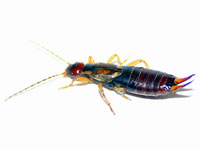Earwigs |
 Many people will agree that earwigs are the more frightening or even loathsome looking insects that can be found in a home. With their chestnut colored bodies, segmented antennae, and muscular, banded abdomen, earwigs are not the prettiest of God's creations. Their most alarming aspect, however, is the set of evil-looking pincers that they carry as a tail. These have caused many a nightmare and cause children, as well as adults, to cringe. The pincers, in fact, can do little damage. Though they look sharp and formidable, they are not sharp enough to pierce human skin. The muscles that control the pincers are strong enough to hold the small prey on which an earwig feeds and may be able to suspend the insect for a moment, but they are not a weapon people need to fear. In fact, earwigs are relatively benign pests, though no one wants to find them in the house. They have not been linked to the spread of any disease and they are non-venomous. Earwigs are found throughout Europe, Asia and the Americas. They are an invasive species that is not native to the New World. They were first reported in North America in the early 1900s, presumably as stowaways from Europe. Earwigs prefer damp, dark places. Their flattened bodies are an evolutionary adaptation for scuttling in tight spaces. They can invade a home through cracks and crevices that may be too small to notice. Earwigs will find them and inhabit the walls of a dwelling where they breed and scavenge meals. Their lifespan is approximately one year during which they molt several times before laying eggs that will bear the next generation. The earwig diet consists of whatever they can find. They eat both plants and other insects, and they will consume household food if available. As small insects, they do not require much food or water to survive. Their preferred damp environment provides them with enough to keep hydrated. They prefer basements to attics and will rarely be found out in the open, though they can live in closets and drawers that suit their needs. They prefer the dark and to be undisturbed by people. Earwigs do not have any special attraction for people's ears. They do not crawl into ears to lay their eggs. This is a legend that has no basis in fact. They are, in fact, somewhat solitary insects that interact only to mate. Females lay between twenty and eighty cream-colored eggs that eventually turn a darker brown. Hatchlings resemble miniature adults with the exception that they are pale white. As the insects grow, they molt newer, outer shells, becoming successively darker as they age. The pincers grow larger as the earwigs mature and males develop curved pincers while the females' remain straight. There are some species that develop wings. |
FREE QUOTE
Let's Get Started...
Save 20% By Scheduling Online...
Address
 Website Powered by BannerOS. Your Business Energized!
Website Powered by BannerOS. Your Business Energized!





